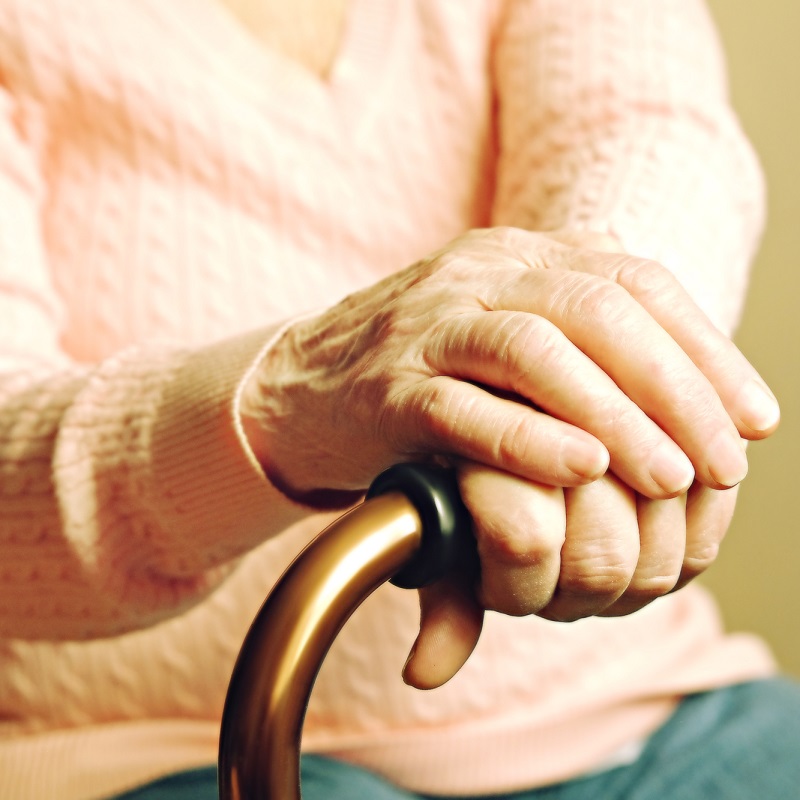Falling down is common but usually a minor incident. However, if not addressed properly, the outcomes can be serious. Juliette Millard, our Head of Clinical Governance, shares how to respond to falls, including advice on assessment and care, to ensure a swift and appropriate response.
Anyone can have a fall but older people are typically at greater risk, especially if they have a long-term health condition. Older people living in care homes are three times more likely to fall than those living in the community, and a quarter are likely to suffer serious injuries and be admitted to hospital following the accident (NICE, 2014).
The Newcross Clinical Excellence Team supports nurses after incidents and complaints, especially when the care of the person may have been compromised. Recent reflective learning and discussions with nurses indicates varying knowledge of how to respond to falls, and this has contributed to delays in the correct treatment for the person who has fallen. In some instances, full body checks have not been completed and injuries may have been exacerbated due to incorrect care. Often documentation is poor and events are not handed over, which has compromised ongoing risk assessments and fall prevention strategies.
Incidence of falls
Data from the NPSA indicate that a significant number of people receiving care fall each year, (around 282,000 patient falls were reported from hospitals and mental health units in 2011). A significant number of these falls result in death, severe or moderate injury, including around 840 fractured hips, 550 other types of fracture, and 30 intracranial injuries (NPSA, 2011). Around one in three adults over 65 who live at home will have at least one fall a year and about half of these will have more frequent falls.
In care homes, falls account for around 90% of reportable injuries, many of these falls are preventable and robust assessments of contributing risk factors should be in place for each person receiving care. After a fall, an older person has a 50% probability of having their mobility seriously impaired and a 10% probability of dying within a year (Help the Aged, 2008). Not all falls can be prevented, some people will fall regardless of any preventative measures put in place, in these circumstances prompt assessment and treatment is critical to any recovery.
Steps on how to respond to falls
There are a number of important steps to take when you you’re required to respond to falls:
- On witnessing a fall or finding someone who has fallen, an initial assessment should be taken.
- Assess the immediate environment for hazards
- Do not move the person unless they are in danger
- Call for assistance from your colleagues, use an emergency bell if one is available.
- Do an ABC check, any airway, breathing or circulation problems call 999.
- If the ABC is stable, check for level of consciousness, if unresponsive call 999
- Complete a head to toe assessment for bone or soft tissue injuries including possible fractures, head or spinal injuries before the person is moved. Any injury that may be serious or if there is any doubt on the persons condition; for example, the fall was unwitnessed and they cannot tell you what happened; and if they are hurt, call 999.
- If your assessment shows non-urgent medical concerns, contact GP/out of hour’s service for advice
- Whilst doing your assessment, consider possible causes of the fall and the nature of the fall, how the person fell and from what height. Consider if the person could be developing an infection for example, any concerns speak to the GP/Out of Hours
- If the person is in pain or there is any evidence of pain or concerns about the limbs/joints (shortening and/or impaired rotation, swelling and/or redness) then the person must be made comfortable where they are, maintain their privacy & dignity DO NOT MOVE THEM – ensure someone stays with the patient, verbally reassuring them and explaining the process. Do NOT move anyone you suspect may have a fracture, head or spinal injury.
- If there is full movement and rotation of limbs and joints and no indication of pain the person may be assisted to rise and mobilise using safe moving & handling techniques. Assess the person’s level of mobility and compare it with their functioning prior to the fall.
- If the person rises from the fallen position independently, assist them to a place of comfort and privacy and continue your assessments and observations.
- Communicate with the person throughout, tell them what you are doing, provide reassurance and keep them as calm and still as possible.
- Consider also the time frame of clinical response and the person’s ongoing condition, you may need to call 999 if their condition deteriorates.
Action
It’s also important to do the following when you respond to falls:
Assess the immediate environment for hazards
Do not put yourself in danger
Do not move the person unless they are in danger
Some injuries can be exacerbated by movement
Call for assistance from your colleagues, use an emergency bell if one is available.
You will need help with the assessment, getting further assistance offering reassurance to the person and any manual handling when it is safe to move the person
Do an ABC check, any airway, breathing or circulation problems call 999.
This initial assessment will help you decide your plan for treatment
If the ABC is stable, check for level of consciousness, if unresponsive call 999
Any concerns regarding levels of consciousness require urgent medical treatment
Complete a head to toe assessment for bone or soft tissue injuries including possible fractures, head or spinal injuries before the person is moved. Any injury that may be serious or if there is any doubt on the persons condition; for example, the fall was unwitnessed and they cannot tell you what happened; and if they are hurt, call 999.
This initial head to toe assessment will ensure you give the most appropriate immediate care without doing any further harm
If your assessment shows non-urgent medical concerns, contact GP/out of hour’s service for advice
Any fall should be reported to the GP/out of hours they can offer advice and follow up as required
Whilst doing your assessment, consider possible causes of the fall and the nature of the fall, how the person fell and from what height. Consider if the person could be developing an infection for example, any concerns speak to the GP/Out of Hours
Was this a fall or collapse this could be a further reason for immediate medical support?i.e. Cardiac or cerebral.
If the person is in pain or there is any evidence of pain or concerns about the limbs/joints (shortening and/or impaired rotation, swelling and/or redness) then the person must be made comfortable where they are, maintain their privacy & dignity DO NOT MOVE THEM – ensure someone stays with the patient, verbally reassuring them and explaining the process. Do NOT move anyone you suspect may have a fracture, head or spinal injury.
Assessment of pain can highlight any injuries you may have missed or areas of concern
If there is full movement and rotation of limbs and joints and no indication of pain the person may be assisted to rise and mobilise using safe moving & handling techniques. Assess the person’s level of mobility and compare it with their functioning prior to the fall.
Rotation of limbs can be a sign of a fracture sometimes the patient may be too shocked or confused to express pain
If the person rises from the fallen position independently, assist them to a place of comfort and privacy and continue your assessments and observations.
The person still needs a full assessment to ensure no hidden injuries or complications
Consider the need to communicate with the person throughout, tell them what you are doing, provide reassurance and keep them as calm and still as possible.
You must always reassure the person and explain your actions this could avoid any further injury
Consider also the time frame of clinical response and the person’s ongoing condition, you may need to call 999 if their condition deteriorates.
When you respond to fall, ongoing observation is very important, as is a quick response to any changes that require medical attention to could avoid further complications
Observations following an unwitnessed fall or where the person fell and hit their head
When you respond to falls, monitor and record observations including vital signs, full body check of bruising, swelling and pain. Observe breathing and circulation plus level of response including verbal and motor responses.
A person who has sustained an unwitnessed fall must have neurological observations completed for at least 24 hours or unless instructed otherwise by a medical officer. Follow NICE guidance 56 for Head Injury assessment
A person who is witnessed to have banged or injured their head must have neurological observations completed. Follow NICE guidance 56 for Head Injury assessment
Frequency of observations should be ½ hourly for 2 hours then hourly for 4 hours then review if stable continue monitoring 2 hourly for 24 hours and report any changes to the GP/Out of Hours immediately. (NICE 2007)
Observations following a witnessed fall where the person did not hit their head
Monitor and record observations of blood pressure, temperature, pulse and rate of respiration and continue for 24 hours unless instructed otherwise by the medical officer. Monitor and record bruising, swelling, pain, circulation, level of consciousness, verbal responses and motor responses.
Observations should be recorded 4 hourly for 24 hours unless otherwise stated by medical officer These can be carried out more frequently and reported immediately if any concerns
Dementia patients or patients with cognitive impairment may be harder to assess any distinct changes in usual behaviour or a change in level of agitation, restlessness or listlessness contact the GP/Out of hour’s immediately
How to complete a head to toe assessment (completed by a registered health professional)
Observe and then examine each limb and joint for redness and/or swelling.
Observe and then examine the person for evidence of any bruising, lacerations or further injury.
observe and then examine the person’s legs and observes for any evidence of shortening or impaired rotation
Observe and then examine head, limbs and joints to determine if there is full movement and rotation in each limb and joint (working from head to toe).
Be aware of the policy for the establishment you are working in. You should ensure you are aware of this policy at the beginning of the shift you should not be looking for this at the time of the fall. Communicate to all your colleagues on shift so they are aware of the any change to care etc.
Once the person is comfortable and safe, complete all documentation (care notes, falls protocol records, risk assessments, accident reports) and inform the management of the establishment and notify next of Kin/family of any fall as outlined in the persons care plans. CQC should be informed of any serious falls and it may be appropriate to report to safeguarding too.
Documentation when responding to a fall
Document all actions and decisions taken with added rationale in the person’s care notes, complete accident/incident records and any specific falls documentation when you respond to falls. All staff involved in the care of the person who has fallen should be informed of the incident including outcomes and any changes to the care plan and risk assessments.
Document all findings any actions taken and rationale for any further decisions of care. Documentation should include:
- The time and location of the fall
- Location of any injury
- Results of the head to toe assessment
- Vital signs
- The cause of the fall if known
- Treatment
- Post-fall interventions
- Statements made by the residents and any witnesses
- Time 999 or GP called and outcome
- Time the family was notified
- New fall intervention implemented to prevent re occurrence of falls
Many falls can be preventable with regular reviews and assessments. However some falls are unavoidable, all falls require immediate assessment action to determine treatment minimise injuries and prevent further falls. A health care professional should carry out a full assessment and react quickly to any injuries or deterioration ensuring the patient gets the correct treatment in the correct environment. Documentation should be accurate and detailed so any risk factors can be highlighted, this will then enable an immediate action plan to be completed and allow further consideration into preventing further falls.
For more healthcare articles, take a look at our blog.
References:
National Institute for Health and Clinical Excellence (NICE) Clinical Guideline 176 (2014): Head injury: assessment and early management, accessed at https://www.nice.org.uk/guidance/cg176 on 14 November 2016
Help the Aged (2008) Towards Common Ground accessed at http://www.housinglin.org.uk/_library/Resources/Housing/OtherOrganisation/towards_common_ground.pdfon 10 November 2016
NPSA, 2011, Rapid Response Report











